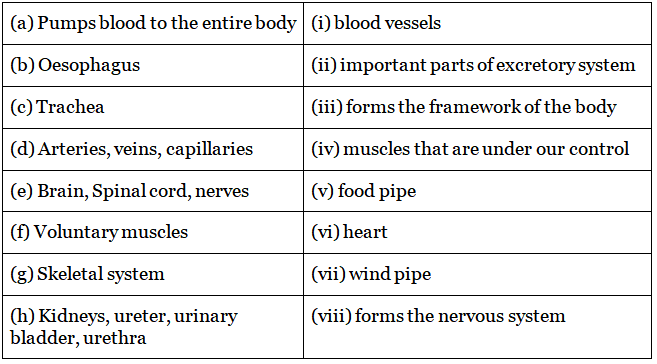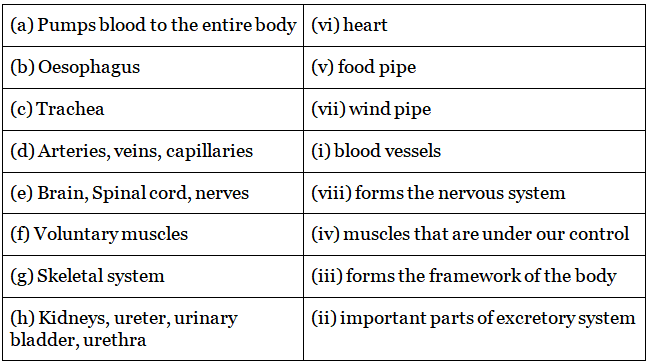Lakhmir Singh & Manjit Kaur Solutions: Skeletal & Nervous System | Lakhmir Singh & Manjit Kaur Solutions: Class 5 Science PDF Download
True & False
Q.1. The images of objects are formed on the retina of our eyes.
True
Q.2. The vertebral column protects the delicate umbilical cord.
False(The vertebral column protects the spinal cord).
Q.3. The ligaments are the strong tissues that hold the bones together.
True
Q.4. The nerves that brings messages from the brain to the spinal cord are called motor nerves.
False (The nerves that brings messages from the brain to the spinal cord are called sensory nerves).
Q.5. The ribcage protects our brain.
False (The ribcage protects the heart and lungs).
Q.6. Write where do we find these joints in our body.
(i) The hinge joint ________.
The hinge joint Elbows, Knees, fingers and toes.
(ii) The ball and socket join ________.
The ball and socket join Shoulders and hips.
(iii) The pivot joint ________.
The pivot joint Neck.
(iv) The gliding joint ________.
The gliding joint Wrist and ankle.
Give one word answer for the following.
Q.7. A cage of bones around the chest ________.
Ribcage
Q.8. A joint that allows back and forth movement ________.
Hinge Joint
Q.9. Muscles in the heart ________.
Cardiac muscles
Q.10. The automatic response of our body ________.
Reflex Action
Q.11. The cord that connects the brain to the nerves ________.
Spinal Cord
Q.12. Match The following
Subjective Type Questions
Q.13. What are the different kinds of muscles and what are their function?
The different kinds of muscles are: Voluntary muscles, Involuntary muscles, Cardiac muscles.
Voluntary muscles: Our Arms, neck, shoulders and legs have voluntary muscles as they are under our control.
Involuntary muscles: Some muscles help in our breathing, movement of food in the stomach and intestines, and flow of blood.. They work on their own and so are called involuntary muscles.
Cardiac Muscle: The muscles of the heart are called cardiac muscles. They pump blood to all the parts of our body and are involuntary in nature.
Q.14. What is the skeletal system? Write all the parts of the skeletal system.
An adult human being has 206 bones in the body which form the skeletal system of the body and give shape to the body.
Parts of the skeletal system: Skull, Vertebra, Sternum, Ribs, Radius, Ulna, Femur, Knee, Tibia, Fibula, Pelvis, Spine, Humerus, Ribcage, Shoulder.
Q.15. Differentiate between sensory nerve and motor nerve.
Q.16. What are reflex actions?
Our body has some automatic response. For example if we touch a hot or sharp object or boiling water, we withdraw our hand immediately. These actions are instant and does not involve the brain and are called reflex actions.
Q.17. Differentiate between movable and immovable joints.
The difference between movable and immovable joints are following:



















